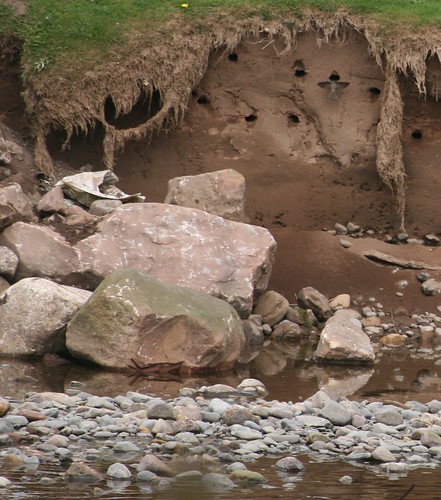It is April in any river in Europe. A swallow is approaching a slope; it’s the smallest of the five existing species. It measures about 12 cm. With its beak and its tiny legs it digs a hole, always wider than it is tall, about 40-50 cm in length. Little by little, it penetrates the wall and disappears. After a final gentle sand rain, the Sand Martin (Riparia riparia) comes out triumphant. The work in the nest is already finished.

Colony of Sand Martin (Riparia riparia) | Autor: far closer · Creative Commos Attribution 2.0 Generic
As we can see, the natural nest of the Sand Martin is usually of cave origin, as it is the nest of the bee-eater or the Common Kingfisher. It nests in colonies located in ledges and slopes of rivers and ponds, although nests inside wells have been found in Spain. But the story is not always the same.
The Sand Martin population in Europe is steady. Great Britain has surpassed a million of ringed Sand Martins, but this little bird is extremely affected by aggregate extraction and river regulation, although it willingly accepts artificial sandy slopes, provided they face north, as well as concrete walls prepared to nesting boxes.
In the Sand Martin census carried out in the Community of Madrid during 1997 and 1998, several curious locations for nesting boxes were mentioned. One of them, beside a motorway near the capital. Several others, close to one of the runways at the Madrid-Barajas airport, and the strangest of all in a little slope supporting the drain pipe of the hippopotamus pond at the Madrid Zoo Aquarium. This is the most unique one, if we bear in mind that the place is visited by hundreds of people every day.
Nests in artificial walls or drain holes in concrete walls have been reported in Spain, the United Kingdom and France. Additionally, there are reports of cavities in reservoirs or little drain pipes in the river Thames in London and in the river Manzanares in Madrid, as well as in the railway slopes in both capitals.
These birds accept nest boxes for nesting, which can be made both of concrete and wood, being the concrete ones the most used in Spain. They are buried in the slopes to give them consistency. When they are set in groups of 5 to 10, they favour the creation of colonies. The box measures 16x26x17 cm, has an access pipe of 58 cm in length as an entrance and 15×12.5 cm in width. Curiously, then the nest box is set individually, it is more often taken by the Common Kingfisher than by the Sand Martin.
In the United Kingdom it is more frequent to set wooden nest boxes than concrete nest boxes in the river banks. They are big crates elevated from the ground by a base. Inside the communal nest, the entrance galleries and nesting boxes are distributed.
As we have seen, despite the modifications carried out at slopes and riverbeds, the Sand Martin, with a little help, can manage to support its offspring.











